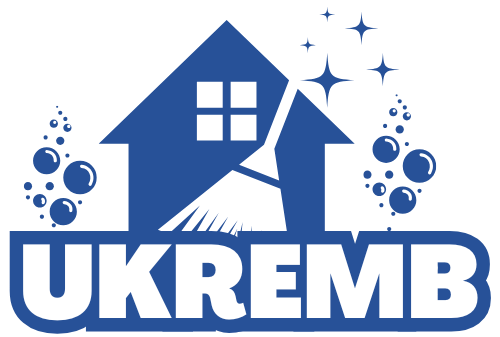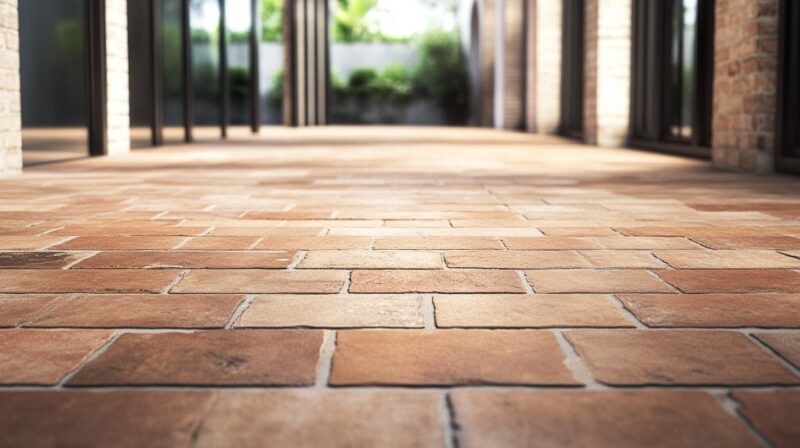Different tiles need different cleaning methods. A single cleaner or mop type cannot protect every surface.
Some materials absorb water fast, others resist most stains but crack under harsh scrubbing. Knowing the right approach saves time and keeps your floors in great shape.
These practical tips cover exactly what each surface needs to stay clean without damage.
1. Vacuum First to Remove Dirt and Grit
Loose dirt causes scratches, dull spots, and grout damage. Before touching any mop, start with a dry clean. Vacuum with a brush attachment or use a soft broom. Focus on corners, tile edges, and between grout lines.
This step prevents surface wear and keeps cleaning water from turning into muddy streaks.
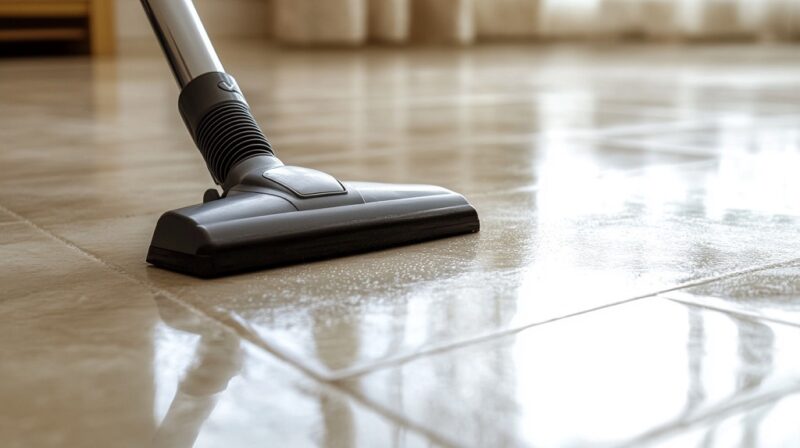
For Thin Brick, Ceramic, and Quarry Tiles
Thin brick surfaces trap grit deep inside the pores. Regular vacuuming is a must. Use low suction and soft bristles to avoid chipping the rough surface.
Ceramic and quarry tiles can take a bit more force but still need careful sweeping to protect grout. Avoid rolling heavy vacuums across loose tiles.
For Vinyl, Linoleum, and Mosaic
These tiles scratch fast if dust builds up. Use a dry microfiber pad or a lightweight vacuum on the lowest setting. For mosaic floors, pay attention to the tiny grout lines. Even a fine layer of dust will dull the shine.
Dry cleaning lays the foundation. Skipping it only pushes dirt deeper into every crack. Always start here.
2. Mop with Warm Water and Mild Soap Only
Water mixed with a small amount of mild soap cleans tiles without harming their surface. Avoid scented or oily detergents. Stick to clear dish soap or pH-neutral products.
Dip a microfiber mop into warm water, wring it well, and clean in short overlapping strokes. For high-traffic areas, change water frequently to prevent spreading grime.
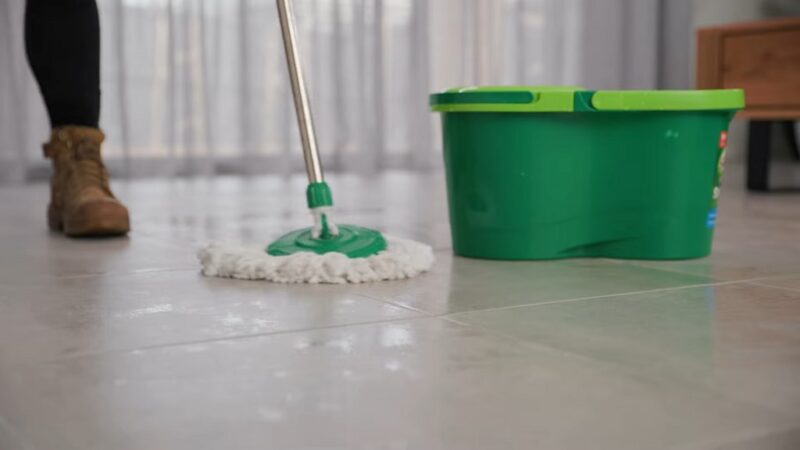
Thin Brick, Quarry, and Cement
These tiles absorb moisture quickly. Never flood the surface. A barely damp mop works best. Make sure to dry with a towel to stop water spots or white marks. Mild soap cleans without wearing down the top layer or affecting sealant.
Vinyl, Linoleum, and Mosaic
These tiles handle more moisture but react badly to harsh soap. Too much soap creates a film. Use one squirt of dish soap per gallon of water. Linoleum needs quick drying after every mop to preserve the finish.
Porcelain, Ceramic, and Glass
Glazed surfaces clean fast with a damp mop and light soap. No need for scrubbing unless stained. Avoid strong-scented cleaners that cloud the shine.
3. Scrub Only Where Needed With a Soft Brush
Scrubbing entire floors wastes time and can ruin delicate finishes. Focus only on stubborn dirt. A soft nylon or natural bristle brush lifts grime without leaving scratches. Scrub in small circles using gentle pressure.
Always rinse the area afterward with clean water to remove any loosened dirt or cleaner.
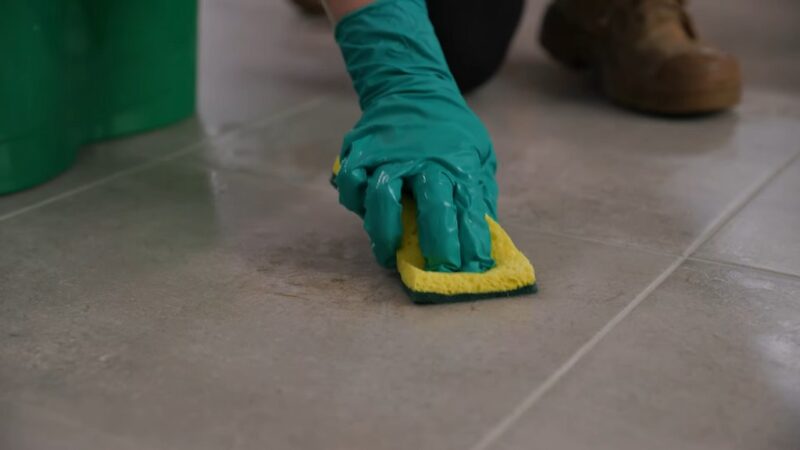
Thin Brick and Natural Stone
Textured surfaces hide dirt deep in the pores. Spot-scrubbing works better than soaking the whole floor. Use stone-safe brushes and cleaners only. Avoid steel brushes that chip corners or scrape edges.
Porcelain, Ceramic, and Mosaic
These tiles clean up fast with minimal effort. A toothbrush works great for edges and corners. Scrub grout lines only as needed, then rinse and dry. For mosaic tiles, avoid brushing too hard across tiny joints.
Vinyl and Linoleum
These scratch easily. Use a soft sponge, not a brush, on scuff marks or sticky patches. Never scrub the same spot more than once.
4. Rinse Everything With Clean Water
Dirty water leaves streaks. Soap film dulls the finish and attracts more dust. Always do a final rinse using clean water and a new mop or sponge. Work in sections. After rinsing, wipe dry with a towel or let air dry with fans for quick results.
Ceramic, Porcelain, and Glass
Soap haze builds up fast on shiny tiles. Rinse with warm water and dry with a microfiber cloth. Avoid air drying if you want a streak-free finish.
Thin Brick, Cement, and Natural Stone
Residual soap can seep into these surfaces and change their color over time. Use a clean damp cloth to go over each section by hand. Never let rinse water pool in cracks or grout lines.
Vinyl, Linoleum, and Quarry
Water spots or streaks show up if floors air dry unevenly. Dry with soft towels or mop up remaining water. Repeat rinsing if any soap smell or stickiness remains.
5. Dry All Surfaces After Cleaning
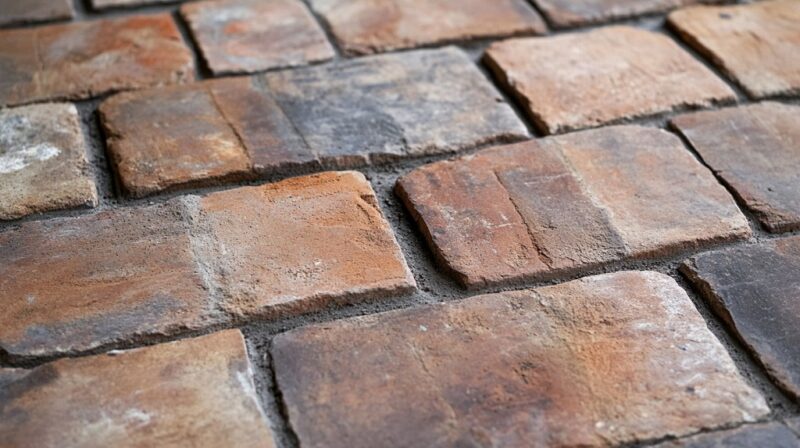
Drying helps prevent streaks, mildew, and water damage. Use a clean microfiber cloth or a soft towel. Work section by section. Press down firmly to soak up leftover moisture. Do not let water sit for too long, especially around grout lines or corners.
Thin Brick, Cement, and Natural Stone
These tiles soak up water deep into their structure. Drying protects sealants and stops moisture stains. Use thick towels and avoid letting rinse water dry on its own. A box fan can speed up drying in large rooms.
Ceramic, Porcelain, and Glass
Drying boosts shine. Use a dry microfiber pad to wipe off any film. Pay extra attention to corners and behind toilets or under appliances. Skip air drying if you want a spotless look.
Vinyl, Linoleum, and Mosaic
Water damage causes peeling and edge warping in these tiles. Use soft cloths and wipe along the tile direction. For mosaic, gently blot between tile pieces.
6. Use Proper Cleaners for Each Tile Type
Not all cleaners work on every surface. pH-neutral solutions are safe for most tiles. Avoid bleach, ammonia, vinegar, or high-acid products unless the label confirms compatibility. Always spot test on a hidden area first.
Thin Brick, Cement, and Natural Stone
Use only stone-safe or neutral cleaners. Acids damage porous materials. Bleach erodes surface texture. Always read labels. Cement tiles in particular lose color fast with the wrong product.
Ceramic, Porcelain, and Glass
These can handle mild acids in small amounts. Vinegar and dish soap work well for bathroom floors. Avoid anything abrasive. Sprays made for glass give a streak-free look on glossy tiles.
Vinyl, Linoleum, and Mosaic
Cleaners with oils or wax buildup fast. Avoid pine-scented or shiny-finish liquids. Stick to diluted soap or gentle floor cleaner with no residue.
7. Maintain Grout Separately and Regularly
Grout lines gather bacteria, stains, and dirt faster than tile surfaces. Scrub them using a toothbrush or detail brush. Apply baking soda paste or grout-specific cleaner.
Rinse and dry completely to stop mold growth. Sealing grout once or twice a year adds extra protection.
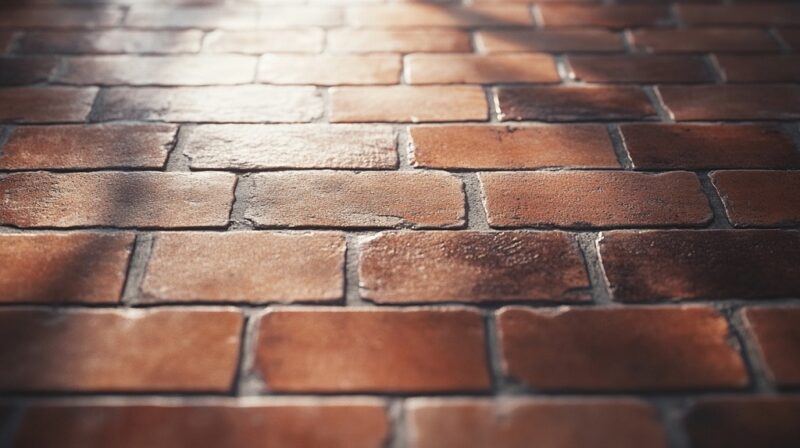
Thin Brick and Quarry
Rough edges trap dust near the grout. Regular brushing prevents buildup. Never soak these floors or you risk pushing dirt deeper into the seams.
Mosaic, Ceramic, and Porcelain
Grout lines are narrow and shallow. Clean them monthly to avoid darkening. Avoid over-wetting when rinsing. Dry immediately using paper towels or cloth strips.
Cement, Vinyl, and Linoleum
Some vinyl and linoleum tiles use surface-level grout effects. These require only mild wiping. Cement with real grout needs deep scrubbing but never with harsh chemicals.
8. Seal or Reseal Tiles That Require Protection
Some tile types need sealing to prevent staining and damage. After cleaning, inspect for fading, discoloration, or water spots. Use a sealer made for that tile type. Apply evenly, let it soak in, and wipe off excess. Allow proper curing time.
Thin Brick, Natural Stone, and Cement
These must be sealed at least once a year. After scrubbing and drying, apply two thin coats of sealant. Sealers stop oil, grease, and soap from entering the tile surface.
Quarry and Porcelain
Quarry often needs sealing due to its unglazed nature. Porcelain usually does not, unless stated by the manufacturer. Read the packaging or ask at purchase.
Vinyl, Linoleum, Glass, and Ceramic
Sealing is not needed for these. Just keep grout lines sealed if present. Clean, dry, and inspect grout yearly to maintain surface strength.
Bottom Line
Cleaning tiles the right way depends on what the surface can handle. One mop or cleaner will never suit all types. Thin brick needs dry care and light moisture. Vinyl and linoleum need quick drying and gentle products.
Natural stone calls for pH-neutral solutions and extra sealing. Every floor tells its own story through the dirt it collects and the shine it loses.
Knowing what each tile type demands saves time, protects your home, and keeps every surface looking sharp. Follow each tip with purpose. Every clean floor starts with the right first step.
